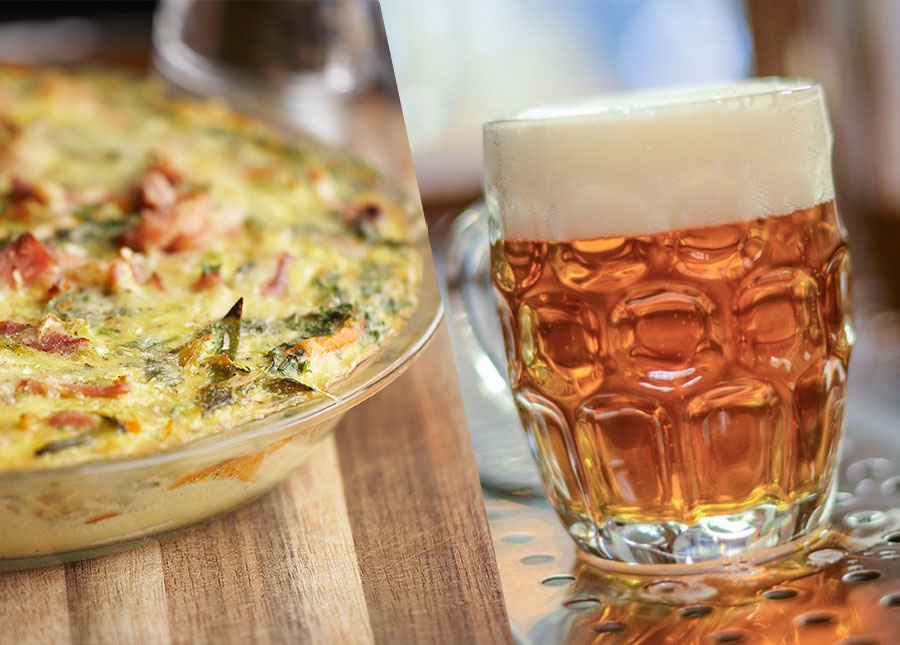
If you’re like me, you consider Saturday mornings to be ritualistic, if not sacred. There’s something so gratifying about easing into the morning, and heck, even having your first meal at noon. Just picture yourself on a weekend whipping up this tasty frittata while you’re waiting to hit your strike water temperature. By that point, we might as well call it brunch, which means a beer pairing is appropriate.
I love cooking recipes that bode well for leftovers, and a frittata is perfect for that. They’re almost better reheated the second time, in my humble opinion (leftovers for bottling day on Sunday?). There’s so much to love about a well-done frittata, from the fluffy texture of the egg to the savory flavors of well-seasoned vegetables and melted cheese to the pure joy of cutting your piece of the pie.
Spinach, Tomato & Bacon Frittata
Ingredients:
- 8 eggs
- 3/4 cup milk
- 6 slices thick-cut bacon
- 1/2 lb. baby spinach
- 4 oz. shiitake mushrooms, halved
- 8 oz. jar of sun-dried tomatoes in oil
- 1 wedge (4 oz.) Gouda cheese, grated
- 1/2 white onion, diced
- 2–3 cloves garlic, minced
- 2 tsp. dried oregano
- 2 tsp. salt (or to taste)
- A few turns fresh cracked pepper
Directions:
Step 1: Preheat your oven 375°F. Grab a cast iron skillet (these work the best because you’ll need to transfer the frittata into the oven later), place over medium heat, and pour oil from the marinated sun-dried tomatoes to coat the pan. Add your diced white onion and minced garlic to the pan. Once the onions and garlic appear translucent, add your sun-dried tomatoes and mushrooms. After about a minute or so, you’ll add the spinach and stir until wilted (it’s important to cook the vegetables before you add the egg so that the frittata doesn’t become too watery with the moisture from the veggies). Be sure to season with salt, pepper, and oregano.
Step 2: In a separate pan, cook your bacon and set aside on a paper towel to absorb the grease. After it has cooled, chop the bacon into small bits with a rolling knife and set aside.
Step 3: While you’re cooking the vegetables, whisk the 8 eggs while slowly adding the milk. Add salt and pepper. Grate your cheese if it isn’t already shredded. Once it looks like most of the moisture has evaporated from your vegetables and they are lightly cooked, pour the eggs into the pan. Add the cheese and the bacon bits.
Step 4: This is really the only opportunity you’ll have to stir the frittata, so lightly stir the mixture until it becomes evenly distributed. You’ll cook the frittata on the stove for no longer than 5 minutes. The eggs will visibly begin to set on the sides of the pan.
Step 5: Once you see that the eggs have set, move the frittata to the oven and cook for 10–12 minutes. Stick a fork in, or a cut a small slit in the top of the frittata to check if the eggs are still runny. If the eggs have set, take the frittata out of the oven and allow it to cool for a few minutes before serving.

Pairing Suggestions
You might have noticed in the ingredients that this frittata calls for an excessive amount of cheese, and while you can certainly use less, I’m going to use the flavor profile of the Gouda to lead my pairing suggestion. Gouda is a semi-hard cheese, which makes it excellent for melted applications because it just amps up that sharp, nutty flavor. Since this dish is lacking in general on the starch side, I think a malt-forward beer like a Märzen or American amber ale would be an excellent choice, particularly a style that has less malty sweetness. The nuttiness of a well-balanced, malt-forward beer will complement the nutty and buttery aspects of the cheese, while the crispy edges of the frittata pair nicely with the toasted, bready malt character.
Märzen Homebrew Recipe
If you’re planning ahead, brew this Märzen recipe, “Pickelhaube Märzen” to go with your frittata.
Specs:
- Original Gravity: 1.056
- ABV: 6%
- IBU: 24
- SRM:10
Ingredients for 5.5 gallons (20.82 L):
- 5.5 lb. (2.49 kg) Vienna malt
- 3.5 lb. (1.59 kg) 10°L Munich malt
- 2.5 lb. (1.13 kg) 20°L Munich malt
- 1.25 oz. (35 g) Tettnang hop pellets, 4.5% a.a. (FWH or 90 min)
- 0.25 oz. (7 g) Tettnang hop pellets, 4.5% a.a. (15 min)
- Bavarian or Munich lager yeast (2 L starter)
- Reverse osmosis (RO) water treated with 1g/gal. calcium chloride
Directions:
To brew the Pickelhaube Märzen, mash in for a protein rest at 122°F (50°C) for 20 minutes. Pull your first decoction of about 9 quarts (9 L) and boil for 15 minutes. Add back to main mash and equalize at 150°F (66°C). Hold at that temperature for 60 minutes. Apply heat or boiling water to mash out at 168°F (76°C) for 10 minutes.
Sparge, boil 90 minutes, and add hops at stated intervals.
Chill and oxygenate when wort temperature falls below 80°F (27°C). Pitch a strong starter of yeast at 48°F (9°C).
Fermentation temperature may be allowed to rise to 50°F (10°C). As fermentation slows, bring to 55°F (13°C) and hold three days for a diacetyl rest.
When the gravity reaches 1.012 (3°P), crash to lager temperatures (35°F or 2°C) and lager the beer for two to three months or until Oktoberfest.
* * *
Hailing from the South, Millie Shamburger has developed an affinity for the beer industry and all the shiny things that come with it. When not exploring beer, Millie is in the kitchen, enjoying the outdoors, and wearing out her dancing shoes.


Share Post